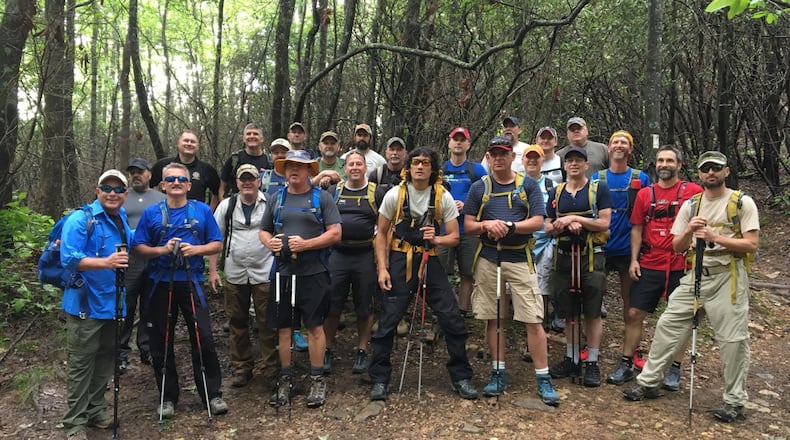Two men climb a slick hill on the Appalachian Trail speaking a special code. Obstacles abound: Their shoes slurp along the muddy path, which is bordered by thick branches jutting in and out. At regular intervals, jagged, moss-coated rocks poke from the muck.
“Got a headbanger here,” says the lead man, tapping an eye-level branch with his trekking pole. He then whacks two large stones between the footpath. “Toebangers here on both sides.”
The man in front, Tom Wilburn, has the use of his eyes to navigate these treacherous obstacles, while the man behind him, Steve Baskis, does not. Both are U.S. military veterans.
In tow are six pairs of other men communicating in the same terse manner.
The hike — which included five American veterans and two British veterans, all with visual impairment or blindness — was sponsored by the Blinded Veterans Association's Operation Peer Support and several partner organizations. About 20 sighted guides volunteered and took turns helping the veterans along the path.
They set out on the hike June 1, ending their 74-mile trek on June 6 at Camp Frank D. Merrill in Lumpkin County. According to organizer Joe Amerling of Murrayville, he and fellow veteran Danny Wallace were inspired by the idea of commemorating the 74th anniversary of D-Day, the Allied invasion of Normandy, France, in World War II, by hiking the same distance in miles on the Appalachian Trail.
“It’s just humbling to be part of this,” said Amerling, steering his pickup truck June 1 after having just dropped off several of the blinded and visually impaired veterans at the starting point — the Georgia border at Blue Ridge Gap.
In addition to helping Amerling organize the adventure, Wallace, a Florida resident and U.S. Army veteran, was one of the men who hiked it. He said that while the group is initially tackling a 74-mile stretch of gorgeous Georgia forest, the goal is to eventually hike the whole trail, which is more than 2,000 miles.
“This year is the first step to get a feel for it,” Wallace said, adding that he hoped the accomplishment would “show (everyone who hears about it) what you can do if you put your mind to it.”
Wallace, who suffered blindness after being injured in 2003 in Iraq, said the message for people with visual impairment or blindness is that “the only obstacles you’re going to face are those that you place on yourself. If you’re willing to face these obstacles … you can do anything.”
Added Wallace: “So many people think life is over when they become blind, and it’s actually not — it’s just the start of a new life.”
Baskis of Colorado, an Army veteran who also lost his sight in Iraq, agreed.
“Even though we’re recognizing history and people who have served … we’re also trying to make people aware of what is possible,” Baskis said. “Whatever your disability is … you can improve your life and start anew. It’s a new normal more or less that I had after losing my sight in the war, but there is a future. That’s part of what we’re trying to say with this hike.”
During the hike, the American and British veterans stopped at the end of each day to eat dinner and discuss different aspects of the D-Day invasion. On the final day, June 6, the veterans rappelled into Camp Merrill to symbolize Army Rangers who climbed the cliffs at Normandy to destroy German gun emplacements.
Amerling said helping put the project together and seeing it to the end were rewarding.
“When I can bring a group of men together as we have done, and just see it click, it’s a good feeling,” Amerling said.
The project's website, Blind Appalachian Trail (blindat.org), described the mission as an opportunity "to help get visually impaired veterans of various abilities out to experience (the trail) … to allow participants the opportunity to overcome their own adversities they face through their injuries and to raise awareness and understanding with the general public and those that may be out there (who) have their own challenges."
Lonnie Bedwell, a Navy veteran who traveled from Indiana for the hike, summed it up: “You may have lost your eyesight, but don’t lose your vision. Look within and grasp that true vision, and you’ll find light in the darkness.”
About the Author
The Latest
Featured





